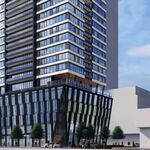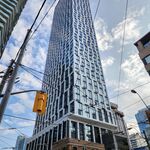Related article from the Star:
Many developers have seen their ambitions for Toronto grow sky-high
Bill Taylor
Jun 22, 2006. pg. R.01
Copyright (c) 2006 Toronto Star, All Rights Reserved.
Buy Land. They're not making it any more.
Mark Twain
Some cities seem hardly to change from one decade to the next. But others ...
If you left Toronto in 1981 and returned today, you wouldn't recognize the skyline. The CN Tower was there 25 years ago but half as many skyscrapers, no Rogers Centre and no condo highrises along Queens Quay.
With the ever-expanding ramparts of suburban subdivisions - Canada's Wonderland is no longer bounded by open fields - we're turning into a 21st-century version of a medieval walled city. A Canadian Carcassonne.
Burying the Gardiner Expressway has become largely academic. There are so many highrises, you can hardly see it - an aesthetic improvement, right there. Driving between them is a swoopy Jetson- style experience. Some condos are so close to the road, you could almost snatch a chicken leg off the barbecue on a balcony as you roar by.
We're in a boom, with 100,000 new people settling in the GTA every year.
And by 2031?
We may be the financial engine that drives Canada but we are by no means masters of our own fate. How the GTA changes over the next quarter-century could be influenced by global forces beyond our control.
"There are some big 'ifs,'" says Larry Bourne, professor of geography and planning at the UofT. He's concerned about our economy, the lack of basic rental units and development fast outstripping infrastructure.
He and Brad Lamb, uncrowned king of the city's condo market, see our future through very different eyes. Not so much glass half-full/ glass half-empty as glass half-full/let's try not to knock the glass over.
Lamb foresees Manhattan north - a hedgehog of housing towers with prices to match.
Paul Bedford hedges his bets "All of the above, probably. I think Brad Lamb's exaggerating but we're going to see condos and townhouses be the primary form of accommodation."
This comes as the province has announced its 25-year Places to Grow plan to house 4 million new residents in the Golden Horseshoe, from Niagara to Peterborough and Collingwood, without allowing urban sprawl to swallow farmland or terminally clog traffic arteries.
Among its demands New development must have increased population density and cities must build "complete communities" where people can live their lives - working, shopping, playing and, presumably, dying - without needing a car.
Bedford, former chief city planner, is doing this already. He lives in a downtown condo. "I haven't owned a car since 1992. It's perfect. What's happening here is what's happened already in European cities, where it's common for people always to have lived in apartment buildings," he said. "It offers the most precious gift you can give any human being - time. If you're no longer doing the long commute, you suddenly have two or three extra hours in your day."
Bedford played a pivotal role in 2002 in drawing up Toronto's first Official Plan, a blueprint for 30 years of growth. But the plan isn't carved in stone, bricks and mortar or concrete. It is, he says, "only a document, subject to interpretation by planning staff, councillors and developers.
"The fundamental anchors of the plan were In 25 years, I would hope it would be possible to live in the city from birth to death and never own a car or feel deprived, because transit is so good. Second, it should be possible to have a variety of housing choices, from your first rental apartment to a nursing home, within your community."
Twenty-five years ago, you wouldn't have seen condo broker Lamb's shaven headshot on billboards telling us that, buying or selling, he's our boy, his finger on the pulse of supply, demand and available space.
In his Toronto, you'll need a head for heights as developers tear down 20-storey buildings and replace them with 50 storeys. Want a conventional house? Better be ready with $1 million for a starter home.
Couples with kids will buy three- or four-bedroom condos "faster than they buy new underwear," even before the concrete has been poured. It's happening faster than we realize, Lamb says. "There are probably 160 condo projects in the GTA right now, with 50 or 60 on the board waiting to happen and another 50 or 60 as a gleam in someone's eye. "If we don't build up, we'll see ourselves running out of real estate and the city will stagnate. When the starting price for a house is a million bucks - and it will be - people will want two-, three-, four-bedroom condos.
"People with more dough will not be treated like like lemmings - and pressured in a sales office. But the time is coming when they will."
Bourne has a fourth-floor office on the corner of College St. and Spadina Ave., "one of the most ethnically and socially diverse intersections in the city."
It's a good vantage point for his "crane index," a rough indicator of how the city's doing. "How many cranes can you see on the horizon? In the early '90s, the recession, none. Now, virtually everywhere you look there are cranes on the skyline."
Developers are keeping pace with the demand for middle-class housing. But low-income accommodation? And the infrastructure to maintain a certain quality of life? Not so much.
"We're not building modest, small rental dwellings for people who have just moved here," says Bourne. "We're not building low-income housing at all. So where are these people? Packing into places like St. James Town and Thorncliffe Park ... being crammed in.
"There's evidence within the middle-income that some of these big houses in the suburbs don't just have two adults and a child; our conventional view of things. There are two families, three families; seven, maybe 10 people ... If three, four, five of them are working, they can carry a substantial mortgage."
Since the 2001 census, he says, the GTA has added "more people than live in London, Ont. Have we built infrastructure for another London? No. Think of a region growing by more or less 100,000 people a year ... the equivalent of a Peterborough, a Kingston, a Brantford ... How many new transit lines and expressways?
"We're not keeping up with roads, schools, parks, water, sewers. We haven't been building hospitals or community services, particularly in the outer suburbs or the inner-city neighbourhoods. If they're lucky, they have the same services they had before, inadequate then and now really inadequate."
Bedford's with him on that one. "We are so far behind in providing transit, it isn't funny. You compare us to Madrid, roughly the same size. They're building dozens and dozens of kilometres of subway continually to keep up with the growth.
"On the good side, there is such a desire for people to live downtown and be able to walk to work. That's a positive thing. It brings life and vibrancy.
"On the negative side, the development industry has abused the theme of intensification. They've interpreted the idea as only happening in one way, the highrise. It falls apart where a developer wants to put a 30-storey highrise on a street next to a single- family housing development. People go nuts, they react, they fight."
For example, there was a well-organized outcry a couple of years ago at a proposed 18-storey condo building in Yorkville. Outraged locals, including author Margaret Atwood and the late urban planning sage Jane Jacobs, fought hard. And lost.
Bourne says regional plans are "based on the assumption that the economy will continue to prosper. They assume immigration will continue at its current level and that most of the immigrants will come here."
But what if growth slows? For example, if European countries with declining birthrates tried to compensate by relaxing immigration policies, "You see where it could become more difficult for Canada to attract immigrants with suitable skills."
If oil price shocks caused an economic slowdown, "Massive cutbacks in the automobile industry would really hammer this region."
Economic decline, as seen in the '90s recession, has wide- reaching tentacles Unemployment undermines the housing market. Construction comes almost to a standstill. There are higher vacancy rates; a reduction in immigration. Municipal revenues fall; there are cutbacks in public services. Social tensions rise; the gap between the haves and the have-nots gapes.
"The percentage of low-income families in Regent Park is 68 per cent; in Lawrence Park it's 5 per cent," says Bourne. "Massive wealth in a few neighbourhoods, extreme poverty in others ... How much inequality can we live with?"
AoD







